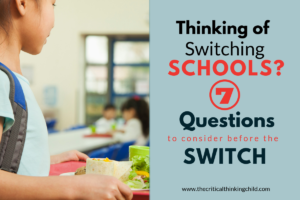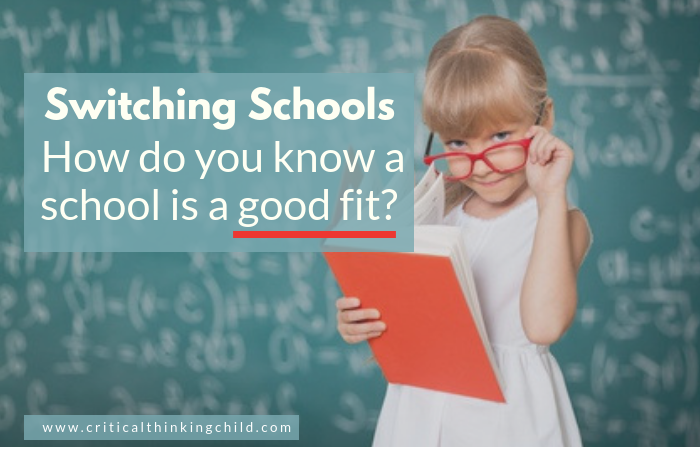What do you do when your child must switch schools? Maybe your family is moving. Maybe the current school is no longer a good fit, or perhaps your child has aged out of their current school.
Whatever the reason, this is a situation many parents encounter, and it can be a nerve-wracking experience. Children, especially those in preschool through early elementary school, should be in the best possible environment to nurture their critical thinking skills. It’s important to make a wise choice.
So how do you determine what will be the best fit for your child? Should you look into public, private, or charter schools? The most important factors to consider are how well the school fits your child’s skill levels and strengths, so asking the right questions is key.
What questions should you ask? Here’s a list of questions to get you started.
Make switching schools a positive experience
One of the most important factors in selecting a school is ensuring it fits your child’s skill levels and strengths.
First, make sure you conduct a thorough search of your options and narrow them down. There are a number of factors to consider when choosing a new school, and if you’re just starting the school search process for your preschooler, this article will help you narrow your options.
Once you have a shortlist of schools, it’s time to start asking questions. Many schools are open to tours for potential students and their families, so take advantage of this whenever possible. A tour will let you take a look inside real classrooms and have your questions answered by a staff member at the school. Other schools have official open houses. During these, potential families can come in for a structured event where they’ll receive a tour, meet staff members, and have an opportunity to ask questions.

7 top questions to consider when switching schools
Below are several examples of questions to ask prospective schools. These questions will help you, as a parent, decide which school environment is best for your child.
What services are provided?
Public schools are required by law to provide exceptional children’s services for any child who has a disability. They often also provide speech and language services, occupational and physical therapy, academically and intellectually gifted services and English as a second language services for students who qualify. If your child needs any of these services and you are looking at a private school, make sure you ask whether these services are provided and consider whether it is financially and logistically feasible for your child to get these services outside of school if the school does not provide them.
What curriculum is used and what standards are taught?
Public schools are tied to teaching national or state standards, but private and charter schools have much more flexibility with what they teach and how they teach it. Ask for a pacing guide or curriculum map to get a sense of what students will learn in each grade.
How is learning structured?
Are students involved in hands-on games and centers, or is the curriculum focused on rote memorization? Is technology integrated? Are students working collaboratively to solve problems or are they sitting at desks the entire day? You can get a sense of this by looking at the physical layout of a classroom, but make sure you ask more questions to see if the atmosphere will fit your student’s learning needs.
What extracurricular activities are available?
Although academic services are important, extracurricular activities are a huge part of a student’s school experience. Inquire about extracurricular activities like sports, drama, art, and music and ask your child if any of the choices are appealing.
What is the student-teacher ratio?
Numerous studies have shown that smaller class sizes have an enormous impact on student achievement. Ask about the average class size in each grade level to determine how much teacher time your student will get. A good class size for K-3 is 20 or fewer students. Also ask about the availability of support staff and teaching assistants. A kindergarten class with 22 students and a full-time teaching assistant will allow your child to get more teacher time than a class with 19 students and no assistant.
What is your teacher turnover rate?
Happy teachers are a huge indicator of a positive school environment. If you learn that the school loses a large number of teachers each year, that’s a red flag. Teachers who stay at a school for many years are able to build community, learn the curriculum and policies, and spend their time teaching rather than learning new procedures. If you can, talk to a few teachers and ask them how they like the school and how long they have taught there.
What is your school mission statement?
Most schools have a school mission statement or vision posted on their website. They may look vague at first, but asking a staff member about the mission statement and how it is integrated into decision-making and daily activities will give insight into the school’s philosophy as a whole. They may be focused on project-based learning, for example, or believe strongly that the arts are essential to learning. Once you find out the mission statement, you can decide whether it aligns with your beliefs about education and your child’s skills and strengths.
Check in with your child early and often
Once you’ve decided on a school, make sure you check in with your child regularly. Monitor their academic progress and overall happiness. You’ll also want to maintain regular contact with your child’s teacher and any administrators who can help you ensure your child is adapting to their new environment.



